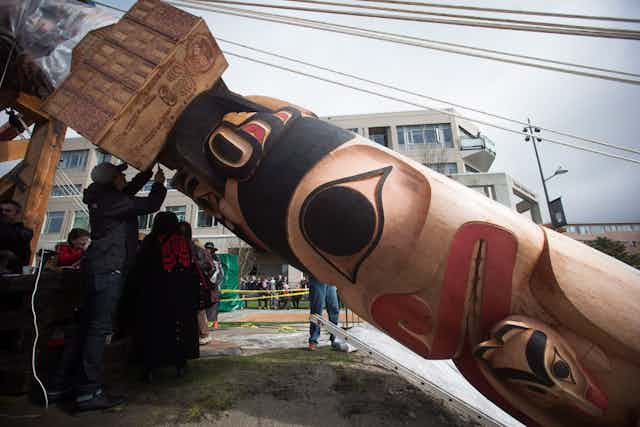“I hear a lot about this so-called ‘inequality’ when it comes to First Nations populations… The problem is the victim mentality… They have to stop seeing themselves as constantly being oppressed.”
As an educator, when I read this university student’s response — to an online discussion post about the existence of social inequality in Canada — I was taken aback.
Education, according to the final report of The Truth and Reconciliation Commission (TRC), can foster renewed relationships between Indigenous and non-Indigenous Canadians. Educators, from elementary to post-secondary, have been called to action to support reconciliation — by incorporating Indigenous content into classroom learning.
Our task is to ensure that students have a respectful understanding of Indigenous peoples and perspectives. To pass on knowledge of residential schools and legacies. When I first read the above student response, this responsibility became even clearer.
But, as teachers, how do we do this? Where do we go for support?
What if we say the wrong thing?
My research examines educator and parent perceptions of the province of Ontario’s commitment to Indigenous student success. In 2007, Ontario developed a policy framework that calls for inclusion of Indigenous content in schooling curriculum. I interviewed 100 Indigenous (mainly Haudenosaunee, Anishinaabe and Métis) and non-Indigenous parents and educators to find out what encouraged and limited implementation of this curricular policy.
I found that some non-Indigenous educators are unaware of Indigenous cultures and histories. Some are intimidated to say or do the wrong thing. Others have difficulty finding, interpreting and using Indigenous curricular resources.
As a result, some students may complete high school and go on to post-secondary education knowing very little about Indigenous peoples in Canada.
As a non-Indigenous educator at the post-secondary level, I also question how best to incorporate Indigenous material into my classrooms. Informal conversations with colleagues suggest that others share similar concerns. For me, the solution has been to reach out and get involved with a community organization.
Amiskwaciy Academy
In September 2016 as I began my first year as an assistant professor at MacEwan University, a colleague invited me to attend a community feast hosted by amiskwaciy Academy. Fred Hines, school principal, welcomed me into the school. Right away, I knew I wanted to be part of this community.
Amiskwaciy Academy is an Edmonton Public School program of choice that provides academic programming within an Indigenous context. The school has a large Indigenous population. It also has strong connections to local Indigenous communities and two full time Elders on staff.
I began volunteering weekly at the school, getting to know students individually and supporting classroom and school activities. I also facilitated opportunities for amiskwaciy students to visit and attend lectures at MacEwan University. And I supported MacEwan students to tutor and assist teachers in the classroom at amiskwaciy.
The time I have spent at amiskwaciy has benefited the students, the school and myself.
Indigenous mentorship
During this time, Fred Hines and the Elders have supported my learning of Indigenous cultures, traditions and ways of knowing and doing. I now consult with Fred on a regular basis. Fred has provided advice and guidance about how to incorporate Indigenous content into my teaching. He has also helped me better understand how to support Indigenous learners.
All experiences and knowledge gained from my time at amiskwaciy have directly informed my university teaching. The school provides similar support to a number of other elementary, secondary and post-secondary educators in the area as well as the broader community.
My experience at amiskwaciy parallels the successful professional development experiences shared with me by non-Indigenous elementary and secondary educators in Ontario. These educators benefited from working one-on-one with an Indigenous coach in the classroom. Coaches had intimate knowledge of Indigenous cultures and worldviews. Through co-teaching and on the ground support, coaches helped educators to meaningfully and authentically incorporate Indigenous content into their regular teaching practice.
Get out and get involved
The TRC suggests that educators, at all levels of schooling, can play a role in reconciling the relationship between Indigenous and non-Indigenous Canadians. It suggests they do that by raising students’ awareness of residential schools, treaties and Indigenous peoples and perspectives.
For example, on Sept. 30 — on Orange Shirt Day — school children across Canada will wear orange to honour survivors of residential schools and commit to the ongoing process of reconciliation.
Much progress has been made over recent years to establish resources and professional development to support elementary, secondary and post-secondary educators — to integrate Indigenous content into classrooms and to implement Indigenous strategic plans and initiatives.
But learning and professional development does not always have to come from top-down policies and initiatives. Any educator, anywhere, can take the initiative to connect with local Indigenous groups and organizations. Get out into the community and get involved. Volunteer time and attend public events. Reaching out to Indigenous centres at your own university or school board office is a great place to start.
My experience has been that by fostering mutually respectful relationships with a community organization, knowledge and understanding follows.
I have so much enjoyed my time with amiskwaciy Academy and admire the educators and staff for the work that they do. I look forward to being part of this school community for many years to come.

